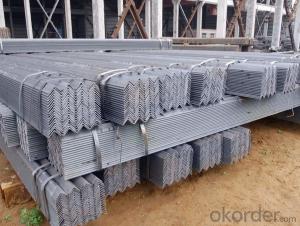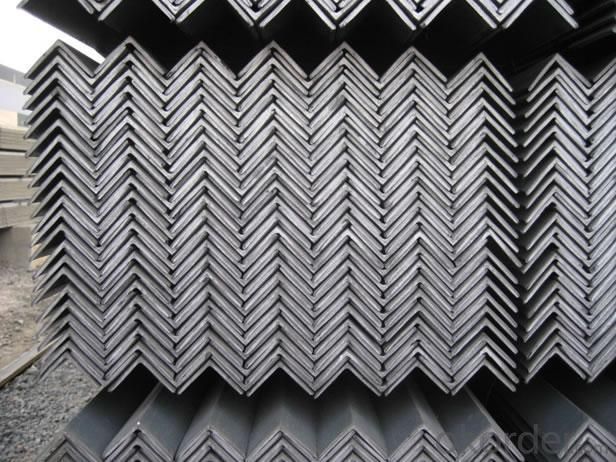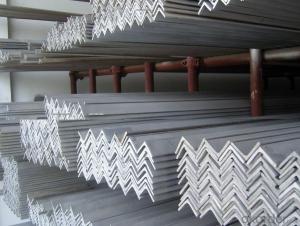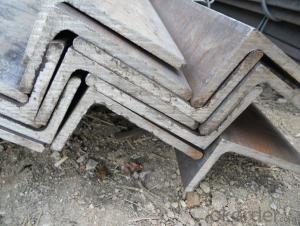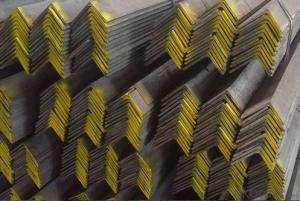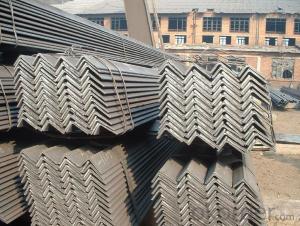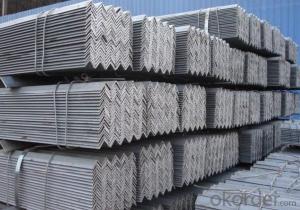Equal Angle Steel and Unequal Angle Steel Hot Rolled
- Loading Port:
- Tianjin
- Payment Terms:
- TT OR LC
- Min Order Qty:
- 25 m.t.
- Supply Capability:
- 20000000 m.t./month
OKorder Service Pledge
OKorder Financial Service
You Might Also Like
Product Description:
OKorder is offering high quality Hot Rolled Steel I-Beams at great prices with worldwide shipping. Our supplier is a world-class manufacturer of steel, with our products utilized the world over. OKorder annually supplies products to European, North American and Asian markets. We provide quotations within 24 hours of receiving an inquiry and guarantee competitive prices.
Product Applications:
According to the needs of different structures, Angle can compose to different force support component, and also can be the connections between components. It is widely used in various building structures and engineering structures such as roof beams, bridges, transmission towers, hoisting machinery and transport machinery, ships, industrial furnaces, reaction tower, container frame and warehouse etc
Product Advantages:
OKorder's Steel I-Beams are durable, strong, and resist corrosion.
Main Product Features:
· Premium quality
· Prompt delivery & seaworthy packing (30 days after receiving deposit)
· Corrosion resistance
· Can be recycled and reused
· Mill test certification
· Professional Service
· Competitive pricing
Product Specifications:
Manufacture: Hot rolled
Grade: Q195 – 235
Certificates: ISO, SGS, BV, CIQ
Length: 6m – 12m, as per customer request
Packaging: Export packing, nude packing, bundled
Sizes: 25mm-250mm | ||||||||||||
a*t | ||||||||||||
25*2.5-4.0 | 70*6.0-9.0 | 130*9.0-15 | ||||||||||
30*2.5-6.6 | 75*6.0-9.0 | 140*10-14 | ||||||||||
36*3.0-5.0 | 80*5.0-10 | 150*10-20 | ||||||||||
38*2.3-6.0 | 90*7.0-10 | 160*10-16 | ||||||||||
40*3.0-5.0 | 100*6.0-12 | 175*12-15 | ||||||||||
45*4.0-6.0 | 110*8.0-10 | 180*12-18 | ||||||||||
50*4.0-6.0 | 120*6.0-15 | 200*14-25 | ||||||||||
60*4.0-8.0 | 125*8.0-14 | 250*25 | ||||||||||
FAQ:
Q1: Why buy Materials & Equipment from OKorder.com?
A1: All products offered byOKorder.com are carefully selected from China's most reliable manufacturing enterprises. Through its ISO certifications, OKorder.com adheres to the highest standards and a commitment to supply chain safety and customer satisfaction.
Q2: How do we guarantee the quality of our products?
A2: We have established an advanced quality management system which conducts strict quality tests at every step, from raw materials to the final product. At the same time, we provide extensive follow-up service assurances as required.
Q3: How soon can we receive the product after purchase?
A3: Within three days of placing an order, we will begin production. The specific shipping date is dependent upon international and government factors, but is typically 7 to 10 workdays.
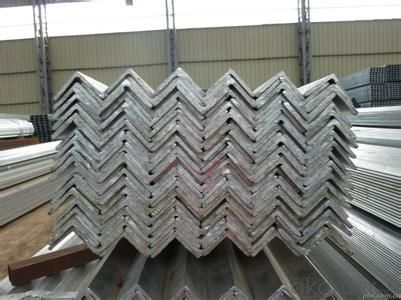
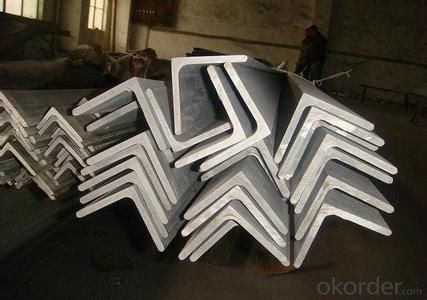
- Q: How do you calculate the moment of resistance for a steel angle?
- The moment of resistance for a steel angle can be calculated by multiplying the yield strength of the material by the plastic section modulus of the angle. The plastic section modulus is determined by considering the extreme fiber locations and their corresponding distances from the centroid of the shape.
- Q: Can steel angles be used for framing purposes?
- Yes, steel angles can be used for framing purposes. They are commonly used in construction for providing structural support and stability in framing applications, such as in the construction of buildings, bridges, and other structures. Steel angles offer strength and durability, making them an ideal choice for framing purposes.
- Q: Are steel angles suitable for mezzanine floor construction?
- Yes, steel angles are suitable for mezzanine floor construction. Steel angles provide structural support and stability, making them a popular choice for building mezzanine floors. They are strong, durable, and can withstand heavy loads, making them an ideal choice for creating additional floor space in industrial or commercial settings.
- Q: Can steel angles be used for framing or supporting mezzanines or elevated platforms?
- Yes, steel angles can be used for framing or supporting mezzanines or elevated platforms. Steel angles provide structural support, stability, and can be easily connected to other steel components. They are commonly used in construction projects for their strength and versatility.
- Q: Can steel angles be used in curtain wall construction?
- Yes, steel angles can be used in curtain wall construction. Steel angles are commonly used as framing members in curtain wall systems to provide structural support and rigidity. They are typically used as mullions or transoms, which are the vertical and horizontal members that hold the glass panels in place. Steel angles are preferred due to their strength, durability, and ability to withstand the loads and stresses of the curtain wall system. Additionally, steel angles can be easily fabricated and installed, making them a popular choice in curtain wall construction.
- Q: What are the common design codes or standards for steel angles?
- The common design codes or standards for steel angles include the American Institute of Steel Construction (AISC) 360, the European Standard EN 10056, and the British Standard BS EN 10056. These codes and standards provide guidelines for the design, fabrication, and installation of steel angles, ensuring structural integrity and safety.
- Q: What are the design considerations when using steel angles?
- When incorporating steel angles into design, there are several important factors to keep in mind. Firstly, the load-bearing capacity of the steel angles must be thoroughly evaluated. The anticipated loads and stresses that the structure will endure should dictate the selection of the appropriate size, thickness, and configuration of the angles. Another factor to consider is the structural integrity of the connections between the steel angles and other design elements. The connections must be designed to provide sufficient strength and stiffness, while also accommodating any potential movement or deformation of the angles. The potential for corrosion when using steel angles should also be taken into account. To prevent rust and deterioration, it is essential to apply suitable protective coatings or treatments, especially in outdoor or high-moisture environments. Aesthetics and visual appeal are also significant considerations in design. The shape, finish, and overall appearance of the steel angles should align with the desired aesthetic of the project, whether it is a modern, industrial look or a more traditional and ornamental design. Finally, cost and availability should be considered when incorporating steel angles. The project's overall budget should be weighed against the cost of materials, fabrication, and installation. Additionally, it is important to consider the availability of the desired sizes and configurations of steel angles to ensure a smooth and timely construction process. By carefully considering these design factors, designers can effectively integrate steel angles into their projects, guaranteeing structural integrity, aesthetic appeal, and cost-effectiveness.
- Q: How do steel angles perform under cyclic loading?
- Steel angles are widely used in various structural applications due to their excellent strength and stiffness properties. When subjected to cyclic loading, which refers to repeated loading and unloading cycles, steel angles perform exceptionally well. Under cyclic loading, steel angles exhibit a phenomenon known as fatigue, which is the progressive and localized structural damage that occurs when a material is subjected to repeated loading and unloading. However, steel angles have a high fatigue resistance, making them highly suitable for applications where cyclic loading is expected. The key factor contributing to the performance of steel angles under cyclic loading is their material properties. Steel, being a ductile and resilient material, is able to deform and absorb energy under cyclic loading, thereby preventing the accumulation of stress concentrations that could lead to failure. Moreover, steel angles are typically designed with a sufficient factor of safety to withstand cyclic loading without compromising their structural integrity. This ensures that they can endure numerous cycles of loading and unloading without experiencing significant deformation or failure. In addition to their inherent material properties, the structural design and fabrication of steel angles also play a crucial role in their performance under cyclic loading. Proper design, including consideration of the expected loading conditions and appropriate reinforcement, ensures that steel angles can withstand cyclic loading without experiencing excessive deformation or stress concentrations. Overall, steel angles are well-suited for applications involving cyclic loading due to their high fatigue resistance, ductility, and structural design considerations. Their ability to withstand repeated loading and unloading cycles makes them a reliable and durable choice in various structural systems.
- Q: What is the standard length of a steel angle?
- The specific requirements and industry or project standards can lead to variations in the standard length of a steel angle. Typically, steel angles are readily accessible in standard lengths of 20 feet or 6 meters. These standard lengths facilitate transportation, handling, and installation. Nevertheless, it is worth mentioning that custom lengths can also be manufactured to fulfill project-specific requirements.
- Q: Are steel angles fire-resistant?
- Yes, steel angles are fire-resistant. Steel is a non-combustible material, and its high melting point makes it resistant to fire. Steel angles are often used in construction to provide structural support and are capable of withstanding high temperatures for extended periods without losing their structural integrity.
Send your message to us
Equal Angle Steel and Unequal Angle Steel Hot Rolled
- Loading Port:
- Tianjin
- Payment Terms:
- TT OR LC
- Min Order Qty:
- 25 m.t.
- Supply Capability:
- 20000000 m.t./month
OKorder Service Pledge
OKorder Financial Service
Similar products
Hot products
Hot Searches
Related keywords
